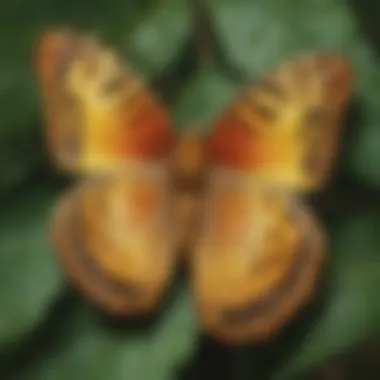Unveiling the Enigmatic Lifecycle of Butterflies: A Journey of Metamorphosis


Science Fun Facts
Butterflies go through a remarkable transformation in their lifecycle. From a tiny egg barely visible to the naked eye, they hatch tiny caterpillars that gorge themselves on leaves. These voracious eaters shed their skin multiple times, growing rapidly before entering the chrysalis stage. Inside this mysterious shell, the caterpillar undergoes a miraculous change, dissolving into a nutrient-rich soup before emerging as a beautiful butterfly. This metamorphosis is a captivating process filled with natural marvels.
Discover the Wonders of Science
Understanding the lifecycle of a butterfly unveils various scientific concepts such as metamorphosis and adaptation. Educational videos and animations can visually showcase this incredible journey, making it easier for elementary school children to grasp the complexity of nature's wonders. By exploring real-life applications of science through the transformation of a caterpillar into a butterfly, young minds can appreciate the intricate mechanisms that drive these enchanting creatures.
Science Experiment Showcase
Engage in a fascinating experiment to simulate the stages of a butterfly's lifecycle. With simple step-by-step instructions and a list of materials required, you can recreate the magic of metamorphosis right at home. Ensure to follow safety tips and precautions to make the learning experience both fun and safe for children and caregivers. By actively participating in this hands-on experiment, families can witness firsthand the miraculous journey of a butterfly from egg to adult, fostering a deeper appreciation for the marvels of nature.
Introduction to Butterflies
Butterflies, enigmatic creatures of nature, captivate the imagination with their graceful beauty and mystical lifecycles. In this detailed exploration of the intricate world of butterflies, we embark on a journey that unveils the mysteries surrounding these delicate winged beings. From the fragile egg stage to the mesmerizing adult form, every phase of a butterfly's lifecycle holds a wealth of fascination and natural marvels waiting to be discovered.
An Overview of Butterflies
The Significance of Butterflies in Nature
Delving into the significance of butterflies in nature reveals their crucial role as pollinators, aiding in the reproduction of flowering plants. The delicate dance between butterflies and flowers showcases a symbiotic relationship that sustains ecosystems and promotes biodiversity. Their graceful flutters not only add splendor to landscapes but also serve as indicators of environmental health and vitality. With their intricate anatomy and behavioral adaptations, butterflies stand as intricate pieces of a vast ecological puzzle, contributing to the symphony of life on Earth.
Butterfly Species Diversity
The vast array of butterfly species presents a treasure trove of biological diversity, reflecting the complexities and wonders of evolution. Ranging from the vibrant colors of tropical butterflies to the subtle hues of temperate species, each butterfly variation symbolizes adaptation to unique habitats and survival strategies. This diversity of winged beauties showcases the resilience and adaptability of nature, offering insights into the interconnectivity of species and the delicate balance of ecosystems. Exploring the nuances of butterfly species diversity unravels a tapestry of life's intricacies, inviting admiration for the myriad forms and functions of these enchanting insects.
Importance of Understanding Butterfly Lifecycles
Educational Value
Unraveling the mysteries of butterfly lifecycles serves as a valuable educational tool, providing students and enthusiasts with a firsthand look at the wonders of metamorphosis. Witnessing the transformation from egg to caterpillar to chrysalis to butterfly offers a hands-on lesson in biology, ecology, and environmental science. The captivating journey of a butterfly's metamorphosis ignites curiosity and instills a sense of wonder, fostering a deep appreciation for the natural world and its complexities.


Environmental Impact
Understanding the lifecycles of butterflies goes beyond educational value, extending to their critical environmental impact. As indicators of ecosystem health, butterflies play a vital role in monitoring environmental changes and highlighting areas of conservation concern. By studying butterfly populations and their interactions with plants and habitats, researchers gain insights into the effects of climate change, habitat loss, and human activities on biodiversity. Protecting butterfly lifecycles means safeguarding the fragile web of life that sustains our planet, emphasizing the interconnectedness of all living beings in a delicate dance of existence.
The Stages of a Butterfly's Lifecycle
The focus of this article now shifts to explore the critical segment of the butterfly's lifecycle, emphasizing the essence of understanding each stage profoundly. Delving into the different phases such as the Egg Stage, Larva (Caterpillar) Stage, Pupa (Chrysalis) Stage, and Adult Butterfly Stage provides a comprehensive insight into the metamorphosis of these fascinating creatures.
Egg Stage
Egg Formation and Characteristics
In this section, we delve into the intricate process behind egg formation and the distinctive characteristics that shape it. Understanding the nuances of egg formation not only sheds light on the beginnings of a butterfly's life but also uncovers the significance of these tiny structures. Analyzing the specific characteristics of butterfly eggs highlights their role in the overall metamorphic journey and underscores why they are a pivotal element in this article's discourse.
Significance of Egg Placement
Exploring the crucial aspect of egg placement unveils its substantial contribution to the butterfly's lifecycle. The strategic positioning of eggs is key to the survival and development of the species. Emphasizing the importance of egg placement delves into the pragmatic implications it has on the overall success of the metamorphic process, underscoring its role as a critical element in our examination of butterfly lifecycles.
Larva (Caterpillar) Stage
Growth and Feeding Habits
Unraveling the growth patterns and feeding habits of larval stages offers profound insights into the development of caterpillars. Understanding the mechanisms driving their growth and dietary preferences not only illuminates their transitional phase but also underscores the significance of these behaviors in shaping the adult butterfly-to-be. Detailing the unique features of larval growth and feeding habits enriches the narrative of this article, providing a nuanced perspective on this integral stage.
Molting Process
Exploring the molting process of caterpillars delves into a critical aspect of their lifecycle. Shedding light on how caterpillars undergo molting sheds light on their adaptive capabilities and growth progression. Highlighting the intricacies of this process showcases the resilience and evolutionary strategies employed by these creatures, which plays a fundamental role in depicting the journey from larva to pupa.
Pupa (Chrysalis) Stage
Metamorphosis within the Chrysalis


Unpacking the transformative process that occurs within the chrysalis illuminates the essence of metamorphosis in the butterfly's lifecycle. Understanding how a pupa undergoes metamorphosis unveils nature's unparalleled ability to craft beauty from simplicity. Highlighting the key characteristics of this metamorphic stage underscores its pivotal role in shaping the miraculous transition from caterpillar to butterfly, enriching the narrative of this article.
Adaptations for Survival
Discussing the adaptations developed by pupae for survival offers a glimpse into the intricate strategies these creatures employ. Exploring the unique features that enable pupae to weather environmental challenges and predators emphasizes their resilience and evolutionary acumen. Delving into the advantages and disadvantages of these adaptations enriches our understanding of how pupae navigate the delicate balance of survival in nature.
Adult Butterfly Stage
Emergence from Chrysalis
The moment of emergence from the chrysalis marks the culmination of a profound metamorphic journey. Capturing this pivotal stage underscores the essence of transformation and evolution in the butterfly's lifecycle. Highlighting the unique features of this emergence process sheds light on the triumph of adaptation and growth, portraying the resilience embedded in the butterfly's journey from pupa to adult.
Life Span and Reproduction
Exploring the lifespan and reproductive behaviors of adult butterflies offers a comprehensive understanding of their role in ecosystem dynamics. Analyzing the key characteristics of butterfly life span and reproduction elucidates their contribution to the conservation of species and biodiversity. Delving into the advantages and disadvantages of these behaviors provides a holistic view of the challenges and triumphs experienced by adult butterflies in their natural habitats.
Metamorphosis: The Wonder of Transformation
Physical Changes During Metamorphosis
Cellular Reorganization:
Within the realm of metamorphosis, Cellular Reorganization stands as a core element driving the profound transformations witnessed in butterflies. The restructuring of cells plays a crucial role in the metamorphic process, facilitating the transition from one stage to another seamlessly. This meticulous cellular rearrangement ensures the development of distinct body parts and features that define each stage of a butterfly's lifecycle. Its significance lies in the orchestration of precise changes essential for the emergence of a fully formed adult butterfly. The adaptability of Cellular Reorganization makes it an ideal mechanism for crafting the intricate beauty of butterflies, showcasing the efficiency and elegance of nature's design.
Nervous System Development:
Another fundamental aspect of metamorphosis is Nervous System Development, crucial for the butterfly's functionalities as it undergoes its transformation. The intricate development of the nervous system equips the emerging adult butterfly with the essential sensory and motor capacities vital for its survival and navigation in the environment. This developmental phase ensures the integration of neural pathways essential for instinctual behaviors and responses to external stimuli. The refinement of the nervous system during metamorphosis exemplifies the intricate adaptation process, highlighting nature's meticulous attention to detail in sculpting these fragile yet resilient creatures.
Behavioral Adaptations
Instinctual Behaviors:


In the realm of butterfly biology, Instinctual Behaviors play a key role in guiding crucial survival activities post-metamorphosis. These innate behaviors are deeply embedded in the genetic makeup of butterflies, enabling them to engage in activities necessary for sustenance, reproduction, and defense. From foraging for nectar to evading predators, instinctual behaviors are the cornerstone of a butterfly's survival strategy. Their instinct-driven actions showcase nature's efficiency in equipping these delicate creatures with the necessary tools for flourishing in their respective ecosystems.
Migration Patterns:
Migration Patterns, a critical behavioral adaptation observed in butterflies, illuminate the remarkable ability of these insects to traverse vast distances in search of optimal conditions for survival. The strategic navigation exhibited through migration patterns reflects the innate intelligence ingrained in butterfly species, enabling them to respond to environmental cues and stimuli effectively. By following established migration routes, butterflies can escape unfavorable conditions and locate suitable habitats for feeding and breeding. This behavioral adaptation underscores the resilience and adaptability of butterflies, emphasizing their capacity to overcome challenges and thrive in diverse landscapes.
Butterfly Conservation and Importance
Butterfly Conservation and Importance play a crucial role in preserving the delicate balance of our ecosystems. By safeguarding butterfly populations, we ensure the continuation of vital pollination processes and the maintenance of biodiversity. Butterflies serve as indicators of environmental health, making them essential in monitoring ecosystem changes. Additionally, their beauty and behavior captivate and educate people of all ages, fostering a deeper appreciation for nature and wildlife. Understanding the significance of Butterfly Conservation and Importance empowers us to take action in protecting these graceful insects.
Threats to Butterfly Populations
Habitat Destruction
Habitat Destruction poses a significant threat to butterfly populations by depriving them of essential resources and nesting grounds. The destruction of natural habitats, such as forests and meadows, due to urbanization and agriculture, limits the availability of food plants and disrupts migration patterns. This disruption leads to a decline in butterfly species diversity and population sizes. Addressing Habitat Destruction requires sustainable land management practices and conservation efforts to preserve vital habitats for butterflies to thrive.
Climate Change Effects
Climate Change Effects exacerbate the challenges faced by butterfly populations through alterations in temperature and weather patterns. Shifts in climate conditions disrupt breeding cycles, migration routes, and habitat suitability for butterflies. Changes in temperature can directly impact butterfly development and survival rates. Mitigating Climate Change Effects necessitates global action to reduce greenhouse gas emissions and implement strategies to adapt to changing environmental conditions to safeguard butterfly populations.
Promoting Butterfly Conservation
Creating Butterfly Habitats
Creating Butterfly Habitats involves designing gardens and green spaces tailored to attract and support butterfly populations. Planting native nectar-rich flowers and host plants provides essential food sources and breeding sites for butterflies. By creating butterfly-friendly environments, we encourage their presence and contribute to increasing their numbers. Establishing Butterfly Habitats in urban areas and public spaces enhances biodiversity and enriches the urban ecosystem.
Education and Awareness
Education and Awareness play a crucial role in promoting Butterfly Conservation by fostering a culture of environmental stewardship and conservation ethics. Educating communities about the importance of butterflies in ecosystems and their role as pollinators cultivates a sense of responsibility towards protecting these valuable insects. Increasing awareness through educational programs, outreach activities, and public campaigns empowers individuals to engage in conservation efforts and make informed decisions supporting butterfly populations.
Conclusion
Appreciating the Magnificence of Butterflies
Final Thoughts on Butterfly Lifecycles
Exploring the culmination of a butterfly's journey through its lifecycles illuminates a crucial aspect of our comprehension of the natural world. Final thoughts on butterfly lifecycles serve as a poignant reminder of the ephemeral yet impactful essence of these stunning creatures. Concluding our voyage through metamorphosis, we are reminded of the cyclical nature of life and the perpetual beauty that unfolds within each winged marvel. The finality of a butterfly's lifecycle symbolizes not just an end but also a beginning, as new generations emerge to continue the dance of life. This portrayal invokes a sense of wonder and contemplation, underscoring the brevity and brilliance of existence. Final thoughts provide a heartfelt connection to the realm of nature, fostering admiration and stewardship for these enigmatic beings in our ecosystems.







